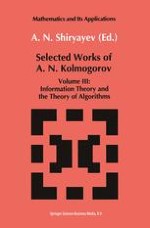1993 | Buch
Selected Works of A. N. Kolmogorov
Volume III: Information Theory and the Theory of Algorithms
herausgegeben von: A. N. Shiryayev
Verlag: Springer Netherlands
Buchreihe : Mathematics and Its Applications
Enthalten in: Professional Book Archive
